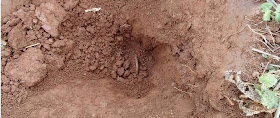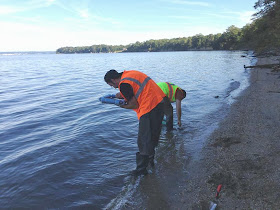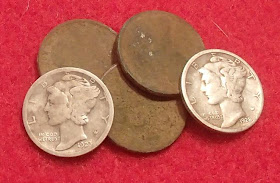Then it was off to DIV XXV at Brandy Rock Farm. The farm included part of the Battle of Brandy Station, as well as winter quarters from the Union 6th Corps during the winter of 1863 - 1864. The property we detected didn't include the historic Farley House (also known as Welford House), but we were able to search many of the nearby fields and woods. Farley was the headquarters for Union General John Sedgwick and Confederate General JEB Stewart, though obviously not at the same time!
Union General John Sedgwick and officers of the 6th Corps at Farley House, winter 1863 - 1864.
Day 1
The start of DIV XXV was a cold one! With frost covering the frozen ground, we made our way out onto the farm. I tried to start in a small patch of woods, but I wasn't the only one with that idea. Between other detectorists and the briars, I didn't have much luck and didn't stay long. Instead, I joined my friends Phil and Todd in a nearby field. Todd was having some luck with a rare Confederate New Austrian bullet, and we all pulled out a few deep targets. Unfortunately, given the depth of the relics in that field, the mineralization of the ground, and the taller grass I was struggling to hear the good targets. While I did find a pair of three ring bullets in that area, I felt I could do better elsewhere and joined my friends Lanny and Lisa on a nearby hill. Not fairing much better there, I continued to look for my "spot" where I could hunker down for the hunt. I finally decided on the soybean field near the headquarters tent, home to a large Union 6th corp encampment. The shorter crop field helped get my coil closer to the ground, and I did have some better luck.
Detecting in the soybean field at Brandy Rock Farm
Several large holes from 6th corp winter huts were starting to open up in the soybean field. One of these was my friend Kieth, who got an impressive array of relics from below the plow line, including two complete bottles, bullets, buttons, clay pipes, and a canteen half. I was thrilled to be able to watch him work. I did get into one pit of my own, the signal coming from a complete barrel band. While the hole was filled with considerable ash and even some larger pieces of broken glass, I only recovered one other relic from hole. At first I thought it looked like modern plastic, but was quickly ID'ed by my friend Todd as a broken piece of a soldier's comb. Sure enough, as I rubbed the dirt from the object I could see a maker's mark from the India Rubber Comb Company, Goodyears Patent May 6 1851. The Goodyears patent refers to the rubber vulcanization process, developed by Charles Goodyear, namesake of Goodyear tires. It would have probably been used for de-lousing, as body lice were a significant problem in Civil War camps.
Broken comb recovered from a hut on day one.
Day 2
I started off day 2 by following a group of friends to a spot where Brian had done well the day before. But again the mineralized ground and taller grass had me struggling to hear the good signals. Before long I wandered back up to a hill near the headquarters tent where I had some success at the end of the day before. With my VLF detector unable to discriminate conductivity at depth in the hot soil, I instead relied on the pinpoint mode to pick out targets based on size and depth ratio. What that also means, unfortunately, is digging square nails. Lots and lots of square nails. They weren't all nails though - some of those targets turned out to be bullets or other relics from the war.
A three ring Minie ball bullet comes into view.
I was pursuing another target right in a huge patch of iron, when I saw something exciting in the bottom of the hole. A rounded edge standing straight up on end, with a green brass front and white lead back. I had my finger crossed that it would be an accoutrement plate of some kind, although I resisted using the "p" word on camera so I didn't jinx it! I was elated when I finally pulled it from the ground to reveal a US cartridge box plate! This makes my fifth Civil War plate find, three of which have come from DIV events.
The edge of the plate in the bottom of the hole.
US Cartridge Box Plate.
Soldiers during the war carried a leather pouch to hold their ammunition, known as a cartridge box. A leather flap closed the box to keep out water and dirt, and the flap was kept closed by fastening it to a brass finial on the bottom of the box. To help make sure the flap remained closed when it was unfastened, a large oval plate with a brass front and lead filled back was attached to weight it down. The design I recovered was used by the Union army bearing the large letters "US" in the same style as the US belt plate. The US box plate can be seen in use in the picture of this unidentified Union soldier below.
Unidentified Union soldier, wearing a cartridge box with a US box plate.
Day 3
Having success in the soybean field on the previous days, I decided to return for the third. Once again I dug more than my share of nails, but several excellent relics as well. I dug a thrilling "first" for me, a New York coat button. In addition to being my first NY, it is in fact my first Union state button of any sort. I also recovered an excellent carved bullet, most likely a chess piece. This carved bullet was the nicest of several carved lead piece I recovered during the hunt.
New York coat button, my first Union state, and an intricately carved bullet
Another highlight of the third day came when I stopped by a newly opening pit being dug out. I introduced myself, and learned that the detectorist, Ed, had been digging huts in the area for many years. He was kind enough to take his own precious detecting time to teach me some lessons in hut digging. When we got to the bottom, we found the signal coming from an intact ration can, with little else but charcoal and animal bone in the hole. Being an experience hut digger, Ed told me he had plenty of ration cans in his collection and offered it to me! The kindness of the folks at DIV never ceases to amaze me. There's a reason John and Rose refer to Diggin' in Virginia as a "family"! The barbeque on day three was quite fun as always. I love getting the chance to eat with my friends and see an impressive museum on display, freshly saved from beneath the earth. We kept on swinging a coil until the sun was nearly set, hoping for that one last relic to save. With darkness closing in, I climbed back into the truck to start the long journey back home to Saxapahaw.
Reflections on DIV XXV
This was my first time at Brandy Rock Farm, and it certainly did not disappoint! Although the ground was some of the hottest I've come across yet, I still managed to find some great artifacts from the American Civil War. My friends all made some great recoveries as well, especially Beau who racked up on bullets and Brian who recovered an amazing engraved corps badge. The box plate was a welcome surprise in the hole, and one I will always fondly remember. All of my finds from the three days at Brandy Rock can be seen below.
All my finds from DIV XXV
The week in Virginia seemed to go by all too quickly, and although I was stiff and sore, I was sad for it all to end. I want to take this time to thank John and Rose Kendrick and the DIV committee for giving me the opportunity to return to DIV; I am incredibly grateful. All their hard work paid off with two highly successful back-to-back events, which seemed to go off without a hitch. I would also like to thank Phil, Lanny, and Lisa for their hospitality during the week - it was a lot of fun getting to spend time with you between detecting. Thanks to Todd and Brian in the carpool and all my DIV family for an amazing week of relic hunting. Thank you to Sham and Randy for the break day hunt, even though I didn't find any relics, I found great memories! Finally, thank you to my wonderful wife Emily and the VCS volunteers who made it possible for me to attend.
I hope to have more finds to share with you all soon, but until then, thanks for reading and God Bless!


















































